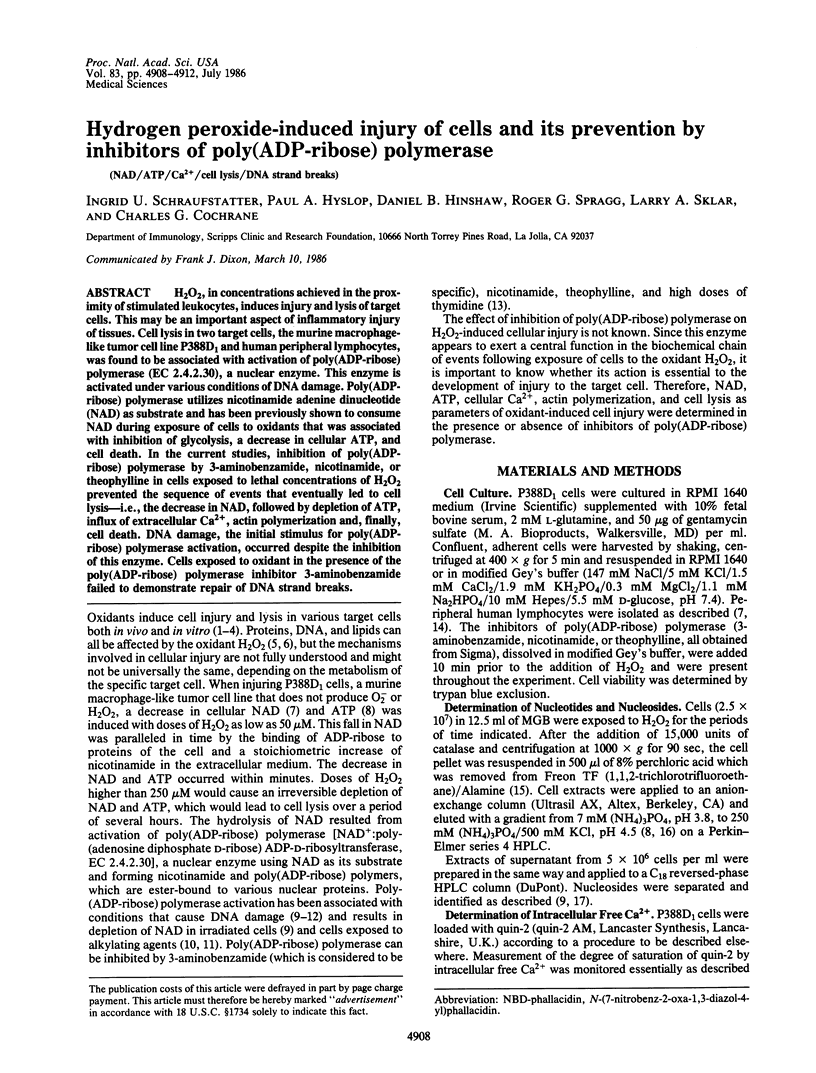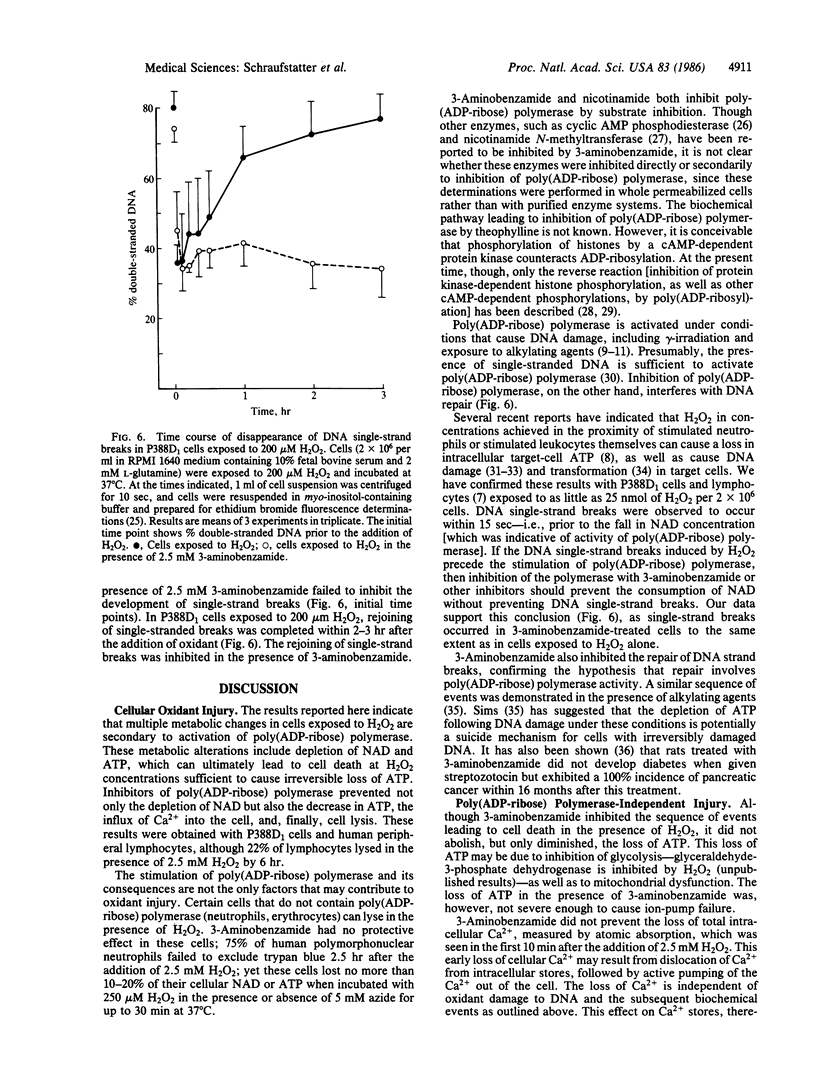Abstract
H2O2, in concentrations achieved in the proximity of stimulated leukocytes, induces injury and lysis of target cells. This may be an important aspect of inflammatory injury of tissues. Cell lysis in two target cells, the murine macrophage-like tumor cell line P388D1 and human peripheral lymphocytes, was found to be associated with activation of poly(ADP-ribose) polymerase (EC 2.4.2.30), a nuclear enzyme. This enzyme is activated under various conditions of DNA damage. Poly(ADP-ribose) polymerase utilizes nicotinamide adenine dinucleotide (NAD) as substrate and has been previously shown to consume NAD during exposure of cells to oxidants that was associated with inhibition of glycolysis, a decrease in cellular ATP, and cell death. In the current studies, inhibition of poly(ADP-ribose) polymerase by 3-aminobenzamide, nicotinamide, or theophylline in cells exposed to lethal concentrations of H2O2 prevented the sequence of events that eventually led to cell lysis--i.e., the decrease in NAD, followed by depletion of ATP, influx of extracellular Ca2+, actin polymerization and, finally, cell death. DNA damage, the initial stimulus for poly(ADP-ribose) polymerase activation, occurred despite the inhibition of this enzyme. Cells exposed to oxidant in the presence of the poly(ADP-ribose) polymerase inhibitor 3-aminobenzamide failed to demonstrate repair of DNA strand breaks.
Full text
PDF




Selected References
These references are in PubMed. This may not be the complete list of references from this article.
- Badwey J. A., Karnovsky M. L. Active oxygen species and the functions of phagocytic leukocytes. Annu Rev Biochem. 1980;49:695–726. doi: 10.1146/annurev.bi.49.070180.003403. [DOI] [PubMed] [Google Scholar]
- Benjamin R. C., Gill D. M. Poly(ADP-ribose) synthesis in vitro programmed by damaged DNA. A comparison of DNA molecules containing different types of strand breaks. J Biol Chem. 1980 Nov 10;255(21):10502–10508. [PubMed] [Google Scholar]
- Birnboim H. C., Jevcak J. J. Fluorometric method for rapid detection of DNA strand breaks in human white blood cells produced by low doses of radiation. Cancer Res. 1981 May;41(5):1889–1892. [PubMed] [Google Scholar]
- Carson D. A., Seto S., Wasson D. B. Lymphocyte dysfunction after DNA damage by toxic oxygen species. A model of immunodeficiency. J Exp Med. 1986 Mar 1;163(3):746–751. doi: 10.1084/jem.163.3.746. [DOI] [PMC free article] [PubMed] [Google Scholar]
- Cerutti P. A. Prooxidant states and tumor promotion. Science. 1985 Jan 25;227(4685):375–381. doi: 10.1126/science.2981433. [DOI] [PubMed] [Google Scholar]
- Howard T. H., Meyer W. H. Chemotactic peptide modulation of actin assembly and locomotion in neutrophils. J Cell Biol. 1984 Apr;98(4):1265–1271. doi: 10.1083/jcb.98.4.1265. [DOI] [PMC free article] [PubMed] [Google Scholar]
- Hyslop P. A., Sklar L. A. A quantitative fluorimetric assay for the determination of oxidant production by polymorphonuclear leukocytes: its use in the simultaneous fluorimetric assay of cellular activation processes. Anal Biochem. 1984 Aug 15;141(1):280–286. doi: 10.1016/0003-2697(84)90457-3. [DOI] [PubMed] [Google Scholar]
- Khym J. X. An analytical system for rapid separation of tissue nucleotides at low pressures on conventional anion exchangers. Clin Chem. 1975 Aug;21(9):1245–1252. [PubMed] [Google Scholar]
- Lewis J. G., Adams D. O. Induction of 5,6-ring-saturated thymine bases in NIH-3T3 cells by phorbol ester-stimulated macrophages: role of reactive oxygen intermediates. Cancer Res. 1985 Mar;45(3):1270–1275. [PubMed] [Google Scholar]
- Lötscher H. R., Winterhalter K. H., Carafoli E., Richter C. Hydroperoxide-induced loss of pyridine nucleotides and release of calcium from rat liver mitochondria. J Biol Chem. 1980 Oct 10;255(19):9325–9330. [PubMed] [Google Scholar]
- Matsumoto S. S., Raivio K. O., Seegmiller J. E. Adenine nucleotide degradation during energy depletion in human lymphoblasts. Adenosine accumulation and adenylate energy charge correlation. J Biol Chem. 1979 Sep 25;254(18):8956–8962. [PubMed] [Google Scholar]
- McWilliams R. S., Cross W. G., Kaplan J. G., Birnboim H. C. Rapid rejoining of DNA strand breaks in resting human lymphocytes after irradiation by low doses of 60Co gamma rays or 14.6-MeV neutrons. Radiat Res. 1983 Jun;94(3):499–507. [PubMed] [Google Scholar]
- Murphy E., Aiton J. F., Horres C. R., Lieberman M. Calcium elevation in cultured heart cells: its role in cell injury. Am J Physiol. 1983 Nov;245(5 Pt 1):C316–C321. doi: 10.1152/ajpcell.1983.245.5.C316. [DOI] [PubMed] [Google Scholar]
- Nathan C. F., Silverstein S. C., Brukner L. H., Cohn Z. A. Extracellular cytolysis by activated macrophages and granulocytes. II. Hydrogen peroxide as a mediator of cytotoxicity. J Exp Med. 1979 Jan 1;149(1):100–113. doi: 10.1084/jem.149.1.100. [DOI] [PMC free article] [PubMed] [Google Scholar]
- Orrenius S., Thor H., Bellomo G. Alterations in thiol and calcium-ion homoeostasis during hydroperoxide and drug metabolism in hepatocytes. Biochem Soc Trans. 1984 Feb;12(1):23–28. doi: 10.1042/bst0120023. [DOI] [PubMed] [Google Scholar]
- Pekala P. H., Moss J. Poly ADP-ribosylation of protein. Curr Top Cell Regul. 1983;22:1–49. doi: 10.1016/b978-0-12-152822-5.50005-1. [DOI] [PubMed] [Google Scholar]
- Pogolotti A. L., Jr, Santi D. V. High-pressure liquid chromatography--ultraviolet analysis of intracellular nucleotides. Anal Biochem. 1982 Nov 1;126(2):335–345. doi: 10.1016/0003-2697(82)90524-3. [DOI] [PubMed] [Google Scholar]
- Richter C., Winterhalter K. H., Baumhüter S., Lötscher H. R., Moser B. ADP-ribosylation in inner membrane of rat liver mitochondria. Proc Natl Acad Sci U S A. 1983 Jun;80(11):3188–3192. doi: 10.1073/pnas.80.11.3188. [DOI] [PMC free article] [PubMed] [Google Scholar]
- Schraufstatter I. U., Hinshaw D. B., Hyslop P. A., Spragg R. G., Cochrane C. G. Oxidant injury of cells. DNA strand-breaks activate polyadenosine diphosphate-ribose polymerase and lead to depletion of nicotinamide adenine dinucleotide. J Clin Invest. 1986 Apr;77(4):1312–1320. doi: 10.1172/JCI112436. [DOI] [PMC free article] [PubMed] [Google Scholar]
- Schraufstätter I. U., Hinshaw D. B., Hyslop P. A., Spragg R. G., Cochrane C. G. Glutathione cycle activity and pyridine nucleotide levels in oxidant-induced injury of cells. J Clin Invest. 1985 Sep;76(3):1131–1139. doi: 10.1172/JCI112068. [DOI] [PMC free article] [PubMed] [Google Scholar]
- Schraufstätter I. U., Revak S. D., Cochrane C. G. Proteases and oxidants in experimental pulmonary inflammatory injury. J Clin Invest. 1984 Apr;73(4):1175–1184. doi: 10.1172/JCI111303. [DOI] [PMC free article] [PubMed] [Google Scholar]
- Seto S., Carrera C. J., Kubota M., Wasson D. B., Carson D. A. Mechanism of deoxyadenosine and 2-chlorodeoxyadenosine toxicity to nondividing human lymphocytes. J Clin Invest. 1985 Feb;75(2):377–383. doi: 10.1172/JCI111710. [DOI] [PMC free article] [PubMed] [Google Scholar]
- Shimoyama M., Kawai M., Nasu S., Shioji K., Hoshi Y. Inhibition of adenosine 3',5'-monophosphate phosphodiesterase by nicotinamide and its homologues in vitro. Physiol Chem Phys. 1975;7(2):125–132. [PubMed] [Google Scholar]
- Sims J. L., Berger S. J., Berger N. A. Poly(ADP-ribose) Polymerase inhibitors preserve nicotinamide adenine dinucleotide and adenosine 5'-triphosphate pools in DNA-damaged cells: mechanism of stimulation of unscheduled DNA synthesis. Biochemistry. 1983 Oct 25;22(22):5188–5194. doi: 10.1021/bi00291a019. [DOI] [PubMed] [Google Scholar]
- Skidmore C. J., Davies M. I., Goodwin P. M., Halldorsson H., Lewis P. J., Shall S., Zia'ee A. A. The involvement of poly(ADP-ribose) polymerase in the degradation of NAD caused by gamma-radiation and N-methyl-N-nitrosourea. Eur J Biochem. 1979 Nov 1;101(1):135–142. doi: 10.1111/j.1432-1033.1979.tb04225.x. [DOI] [PubMed] [Google Scholar]
- Slater T. F. Free-radical mechanisms in tissue injury. Biochem J. 1984 Aug 15;222(1):1–15. doi: 10.1042/bj2220001. [DOI] [PMC free article] [PubMed] [Google Scholar]
- Smulson M. E., Schein P., Mullins D. W., Jr, Sudhakar S. A putative role for nicotinamide adenine dinucleotide-promoted nuclear protein modification in the antitumor activity of N-methyl-N-nitrosourea. Cancer Res. 1977 Sep;37(9):3006–3012. [PubMed] [Google Scholar]
- Spragg R. G., Hinshaw D. B., Hyslop P. A., Schraufstätter I. U., Cochrane C. G. Alterations in adenosine triphosphate and energy charge in cultured endothelial and P388D1 cells after oxidant injury. J Clin Invest. 1985 Oct;76(4):1471–1476. doi: 10.1172/JCI112126. [DOI] [PMC free article] [PubMed] [Google Scholar]
- Tanigawa Y., Tsuchiya M., Imai Y., Shimoyama M. ADP-ribosylation regulates the phosphorylation of histones by the catalytic subunit of cyclic AMP-dependent protein kinase. FEBS Lett. 1983 Aug 22;160(1-2):217–220. doi: 10.1016/0014-5793(83)80970-3. [DOI] [PubMed] [Google Scholar]
- Till G. O., Johnson K. J., Kunkel R., Ward P. A. Intravascular activation of complement and acute lung injury. Dependency on neutrophils and toxic oxygen metabolites. J Clin Invest. 1982 May;69(5):1126–1135. doi: 10.1172/JCI110548. [DOI] [PMC free article] [PubMed] [Google Scholar]
- Tsien R. Y., Pozzan T., Rink T. J. Calcium homeostasis in intact lymphocytes: cytoplasmic free calcium monitored with a new, intracellularly trapped fluorescent indicator. J Cell Biol. 1982 Aug;94(2):325–334. doi: 10.1083/jcb.94.2.325. [DOI] [PMC free article] [PubMed] [Google Scholar]
- Ushiroyama T., Tanigawa Y., Tsuchiya M., Matsuura R., Ueki M., Sugimoto O., Shimoyama M. Amino acid sequence of histone H1 at the ADP-ribose-accepting site and ADP-ribose X histone-H1 adduct as an inhibitor of cyclic-AMP-dependent phosphorylation. Eur J Biochem. 1985 Aug 15;151(1):173–177. doi: 10.1111/j.1432-1033.1985.tb09082.x. [DOI] [PubMed] [Google Scholar]
- Weiss S. J., Young J., LoBuglio A. F., Slivka A., Nimeh N. F. Role of hydrogen peroxide in neutrophil-mediated destruction of cultured endothelial cells. J Clin Invest. 1981 Sep;68(3):714–721. doi: 10.1172/JCI110307. [DOI] [PMC free article] [PubMed] [Google Scholar]
- Weitberg A. B., Weitzman S. A., Clark E. P., Stossel T. P. Effects of antioxidants on oxidant-induced sister chromatid exchange formation. J Clin Invest. 1985 Jun;75(6):1835–1841. doi: 10.1172/JCI111897. [DOI] [PMC free article] [PubMed] [Google Scholar]
- Weitzman S. A., Weitberg A. B., Clark E. P., Stossel T. P. Phagocytes as carcinogens: malignant transformation produced by human neutrophils. Science. 1985 Mar 8;227(4691):1231–1233. doi: 10.1126/science.3975611. [DOI] [PubMed] [Google Scholar]
- Yamagami T., Miwa A., Takasawa S., Yamamoto H., Okamoto H. Induction of rat pancreatic B-cell tumors by the combined administration of streptozotocin or alloxan and poly(adenosine diphosphate ribose) synthetase inhibitors. Cancer Res. 1985 Apr;45(4):1845–1849. [PubMed] [Google Scholar]
- Yamamoto H., Uchigata Y., Okamoto H. Streptozotocin and alloxan induce DNA strand breaks and poly(ADP-ribose) synthetase in pancreatic islets. Nature. 1981 Nov 19;294(5838):284–286. doi: 10.1038/294284a0. [DOI] [PubMed] [Google Scholar]


